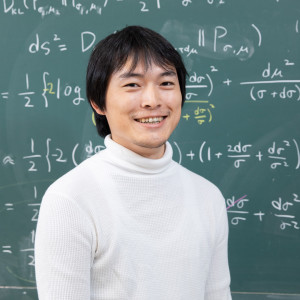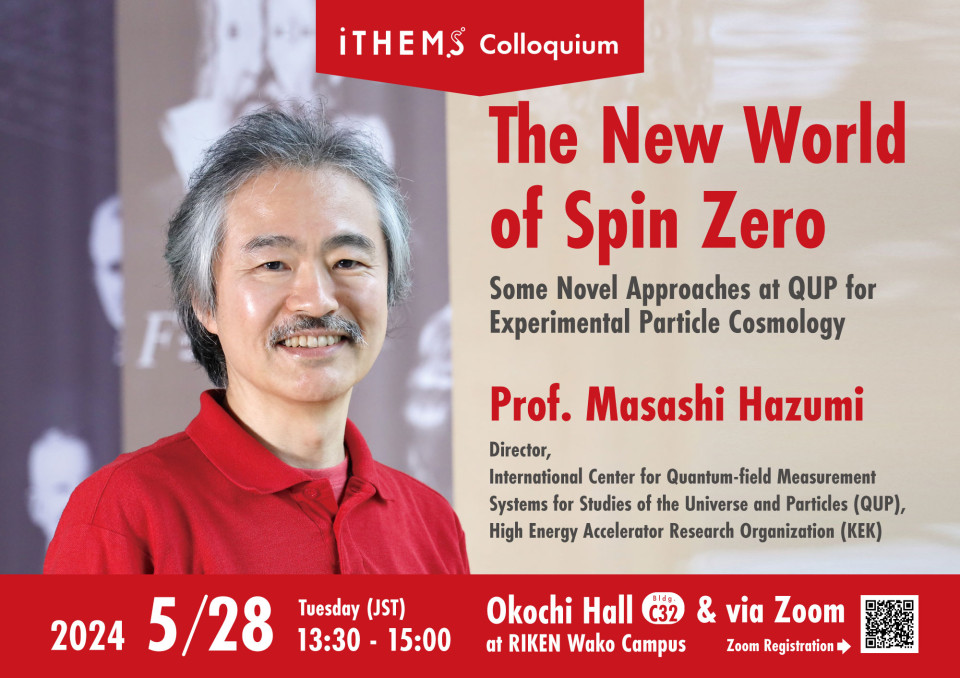Volume 289
Back to Newsletter List
Announcement
Takemasa Miyoshi will give a talk at the RIKEN Science Lecture
2024-02-02
A scientific lecture introducing RIKEN's research activities will be held on February 23 (Fri., national holiday) at the Miraikan Hall of the National Museum of Emerging Science and Innovation. Takemasa Miyoshi (Deputy Program Director, iTHEMS) is one of the speakers and will give a talk titled "Creating Guerrilla Rainstorms Inside Computers."
For more information, please see the related links.
Award
Tomoki Ozawa was awarded the 6th Teruo Hiruma Photon Science Award
2024-02-02
Tomoki Ozawa (Visiting Sciencetist, iTHEMS) was awarded the 6th Teruo Hiruma Photon Science Award for his research on "Theoretical Proposal and Demonstration of Artificial Dimensions in Topological Photonics."
The award ceremony will be held on March 4, 2024.
Congratulations!
Award
Akinori Tanaka received the 29th Outstanding Paper Award
2024-02-02
Akinori Tanaka (Senior Research Scientist, iTHEMS (concurrent)) received the 29th Outstanding Paper Award of the Physical Society of Japan for his "Detection of Phase Transition via Convolutional Neural Networks”.
Congratulations!
Upcoming Events
Seminar
iTHEMS Biology Seminar
Cellular-level left-right asymmetry, cell chirality, induces the chiral collective rotation of multicellular colony
February 15 (Thu) 16:00 - 17:00, 2024
Tomoki Ishibashi (Special Postdoctoral Researcher, Laboratory for Physical Biology, RIKEN Center for Biosystems Dynamics Research (BDR))
Ryohei Nishizawa (Ph.D. Student, Graduate School of Frontier Biosciences, Osaka University)
The left-right (LR) asymmetric morphology of organs is essential for the development and maintenance of their functions in various species. In recent years, it has become clear that the LR asymmetry of organs originates from cell chirality, the LR asymmetric nature at the cellular level [1]. However, it is unclear how the cell chirality generates the LR asymmetry at the multicellular level. Here we show a mechanism of LR asymmetry formation at the multicellular level based on cell chirality. We previously found that Caco-2 cells, a typical cultured epithelial cell line derived from human colon cancer, exhibit stereotypical and directional cell chirality; when Caco-2 cells are cultured as single cells, their nuclei and cytoplasm rotate in the clockwise direction at a rate of 50°/h [2]. Interestingly, when Caco-2 forms multicellular colonies, the colonies also undergo a collective clockwise rotation at 10º/h. We revealed that the actomyosin cytoskeleton is essential for the formation of the collective rotation [2]. We also found that Caco-2 cells formed lamellipodia and focal adhesions LR asymmetrically during the collective colony rotation, which may be responsible for the chiral collective motion. Interestingly, the disruption of microtubules reversed the direction of collective rotation. The LR asymmetric formation of lamellipodia and focal adhesions was also reversed by inhibition of microtubule polymerization. We will discuss the possible mechanism and the mathematical model where cell chirality induces multicellular chiral rotation depending on microtubules.
References
- Utsunomiya, S., Sakamura, S., Sasamura, T., Ishibashi, T., Maeda, C., Inaki, M., Matsuno, K., "Cells with Broken Left–Right Symmetry: Roles of Intrinsic Cell Chirality in Left–Right Asymmetric Epithelial Morphogenesis", Symmetry 11(4), 505 (2019), doi: 10.3390/sym11040505
- Yamamoto, T., Ishibashi, T., Kiyosue-Mimori, Y., Hiver, S., Tokushige, N., Tarama, M., Takeichi, M., Shibata, T., "Epithelial cell chirality emerges through the dynamic concentric pattern of actomyosin", bioRxiv 2023.08.16.553476, doi: 10.1101/2023.08.16.553476
Venue: Seminar Room #359, 3F Main Research Building, RIKEN / via Zoom
Event Official Language: English
Lecture
An introduction to the exact WKB analysis via the hypergeometric differential equation
February 19 (Mon) - 22 (Thu) 2024
Takashi Aoki (Professor Emeritus, Faculty of Science and Engineering, Kinki University)
This is an introductory course to the exact WKB analysis. Firstly we review some basic facts concerning formal power series and WKB solutions. Secondly we give an overview of the connection formulas for WKB solutions to ordinary differential equations of second order with a large parameter. Next, after recalling some classical theory for the Airy equation and the Gauss hypergeometric differential equation, we show how the exact WKB analysis is used for these equations and what are obtained. One of the main results to be presented in this course is the relation the between the classical hypergeometric function and the Borel resummed WKB solutions to the hypergeometric differential equation with a large parameter. Some applications and recent topics are also given.
[Schedule (Tentative)]
Day 1
10:00 - 11:30 Lecture 1
14:00 - 16:00 Lecture 2
Day 2
10:00 - 11:30 Lecture 3
14:00 - 16:00 Lecture 4
Day 3
10:00 - 11:30 Lecture 5
14:00 - 16:00 Lecture 6
Day 4
10:00 - 11:30 Lecture 7
14:00 - 16:00 Lecture 8
[Contents]
- Introduction
- Exact WKB analysis for ordinary differential equation of second order with a large parameter
- Some classical theory for the Airy equation and the Gauss hypergeometric equation
- Exact WKB analysis for the Airy equation
- Exact WKB analysis for the Gauss hypergeometric equation
- Some applications and recent topics
Venue: Seminar Room #359, 3F Main Research Building, RIKEN / via Zoom
Event Official Language: English
Workshop
Second Workshop on Fundamentals in Density Functional Theory (DFT2024)
February 20 (Tue) - 22 (Thu) 2024
The density functional theory (DFT) is one of the powerful methods to solve quantum many-body problems, which, in principle, gives the exact energy and density of the ground state. The accuracy of DFT is, in practice, determined by the accuracy of an energy density functional (EDF) since the exact EDF is still unknown. Currently, DFT has been used in many communities, including nuclear physics, quantum chemistry, and condensed matter physics, while the fundamental study of DFT, such as the first principle derivations of an accurate EDF and methods to calculate many observables from obtained densities and excited states. However, there has been little opportunity to have interdisciplinary communication.
On December 2022, we had the first workshop on this series (DFT2022) at Yukawa Institute for Theoretical Physics, Kyoto University, and several interdisiplinary discussions and collaborationd were started. To share such progresses and extend collaborations, we organize the second workshop. In this workshop, the current status and issues of each discipline will be shared towards solving these problems by meeting together among researchers in mathematics, nuclear physics, quantum chemistry, and condensed matter physics.
This workshop mainly comprises lectures/seminars on cutting-edge topics and discussion, while a half-day session composed of contributed talks is also planned.
This workshop is partially supported by iTHEMS-phys Study Group. This workshop is a part of the RIKEN Symposium Series.
The detailed information can be found in the workshop website.
Venue: 8F, Integrated Innovation Building (IIB), Kobe Campus, RIKEN / via Zoom
Event Official Language: English
Colloquium
iTHEMS Colloquium
The New World of Spin Zero - Some Novel Approaches at QUP for Experimental Particle Cosmology -
May 28 (Tue) 13:30 - 15:00, 2024
Masashi Hazumi (Director, Professor, International Center for Quantum-field Measurement Systems for Studies of the Universe and Particles (QUP), High Energy Accelerator Research Organization (KEK))
Particle cosmology is a discipline seeking a fundamental understanding of the Universe based on particle physics. Five mysteries drive our research today: cosmic inflation, baryon asymmetry, neutrino properties, dark matter, and dark energy.
Resolving any of the five mysteries will revolutionize our picture of the Universe. Numerous interesting theoretical hypotheses have been proposed to this end. Many require new scalar quantum fields, such as inflatons, axions, supersymmetric particles, etc. They are, in a sense, an attempt to expand the role of the vacuum. Since we have not found such spin-zero fields yet, we shall invent new eyes to make an experimental or observational breakthrough.
The International Center for Quantum-field Measurement Systems for Studies of the Universe and Particles (QUP) was established in December 2021 at KEK under the WPI program of MEXT and JSPS. With its tagline of "bring new eyes to humanity," one of the primary missions of QUP is inventing and developing such new eyes for particle cosmology. In this seminar, after briefly introducing QUP, I focus on research topics I have contributed, including the LiteBIRD satellite to study inflatons and light scalar quantum field searches with novel methods using quantum sensing techniques.
Venue: Okochi Hall, 1F Laser Science Laboratory, RIKEN / via Zoom
Event Official Language: English
Seminar
ABBL-iTHEMS Joint Astro Seminar
Do plants have bones? Silica phytoliths and their role and fate in the development of terrestrial plants and human civilizations
March 1 (Fri) 14:00 - 15:15, 2024
Mikhail Blinnikov (Professor, St. Cloud State University, USA)
Silicon is the second most common element in the Earth’s crust. Some families of higher plants evolved mechanisms for soluble silica to be carried by xylem from groundwater and deposited as plant opal in or around plant cells as phytoliths thought to play a role in the structural support and defense against herbivores. While known since the early 19th century, phytoliths remain an intriguing class of microfossils whose formation and role in plants and their preservation in soils and sediments are a subject for a lot of active research. I outline some emerging themes in phytolith analysis including phytoliths’ role in global biogeochemical cycles, plant-herbivore interactions, and their tracing of evolution of cultural plants, especially cereals such as rice (Oryza), wild rice (Zizania), maize (Zea), wheat (Triticum) and millet (Panicum), all relevant to global archaeology. Some emerging research on phytoliths connects their changes in shapes to plant taxonomy of some families such as grasses and opens up avenues for further investigation of their active construction in the cells of some taxa by yet undiscovered genetically mediated mechanisms. New image analysis techniques and some advanced microscopy methods will allow us to further the field of phytolith study using deep machine learning algorithms and true 3D analysis of their shapes, something where contribution from other branches of science are most welcome.
Venue: Seminar Room #359, 3F Main Research Building, RIKEN / via Zoom
Event Official Language: English
Paper of the Week
Week 2, February 2024
2024-02-08
Title: Non-relativistic trace anomaly and equation of state in dense fermionic matter
Author: Hiroyuki Tajima, Kei Iida, Haozhao Liang
arXiv: http://arxiv.org/abs/2402.04960v1
Title: Evolutionary and ecological trends in the Neotropical cycad genus Dioon (Zamiaceae): An example of success of evolutionary stasis
Author: José Said Gutiérrez-Ortega, Miguel Angel Pérez-Farrera, Mitsuhiko P. Sato, Ayumi Matsuo, Yoshihisa Suyama, Andrew P. Vovides, Francisco Molina-Freaner, Tadashi Kajita, Yasuyuki Watano
Journal Reference: Ecological Research
doi: https://doi.org/10.1111/1440-1703.12442
If you would like to cancel your subscription or change your email address,
please let us know via our contact form.
Copyright © iTHEMS, RIKEN. All rights reserved.






